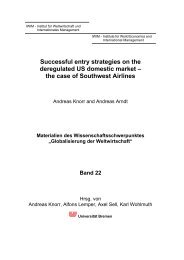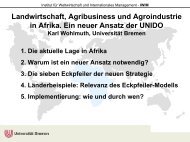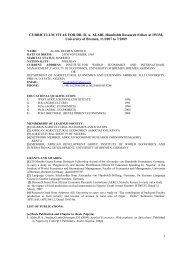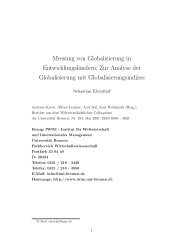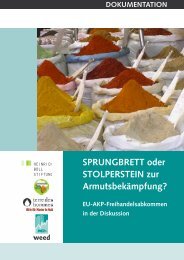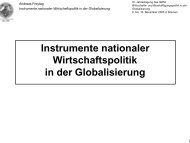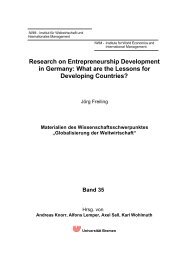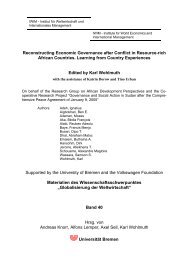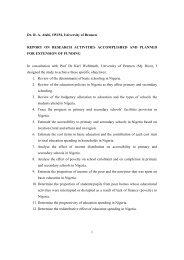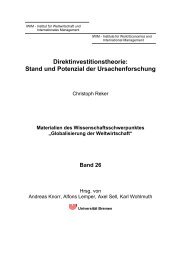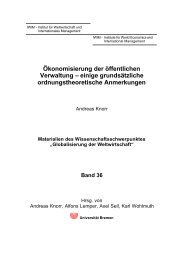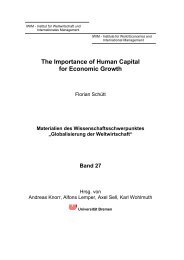Sectoral Analysis of Impact of Foreign Aid in Nigeria - Institute for ...
Sectoral Analysis of Impact of Foreign Aid in Nigeria - Institute for ...
Sectoral Analysis of Impact of Foreign Aid in Nigeria - Institute for ...
Create successful ePaper yourself
Turn your PDF publications into a flip-book with our unique Google optimized e-Paper software.
11<br />
decl<strong>in</strong>es <strong>in</strong> the flow <strong>of</strong> aid? Studies by Corden (1984), Killick (1991) and Nyoni (1997) have<br />
confirmed that huge receipts <strong>of</strong> <strong>for</strong>eign aid by develop<strong>in</strong>g countries do have effects on growth<br />
similar to those <strong>of</strong> the discovery <strong>of</strong> natural resources. On the other hand, Bevan et al (1993)<br />
noted that the effects <strong>of</strong> <strong>in</strong>creased f<strong>in</strong>ancial resources depend on the type <strong>of</strong> expenditure the<br />
boom (aid) f<strong>in</strong>ances.<br />
5.0 Methodology<br />
This study will cover a period <strong>of</strong> thirty years rang<strong>in</strong>g from 1981 to 2010. The data <strong>for</strong><br />
the study will be sourced from the Central Bank <strong>of</strong> <strong>Nigeria</strong> (CBN), National Bureau <strong>of</strong><br />
Statistics (NBS) and the Organization <strong>for</strong> Economic Cooperation and Development (OECD)<br />
websites. The data on GDP <strong>for</strong> each <strong>of</strong> the sector <strong>of</strong> the economy on time series are readily<br />
available <strong>in</strong> the CBN publications and website. Data on health and education outcomes on<br />
yearly basis can be accessed from NBS publications and website. As <strong>for</strong> ODA data, they are<br />
available as OECD Stat at the OECD website. They are available on the aggregate and<br />
disaggregate <strong>for</strong>ms. For example there is ODA allocation to <strong>Nigeria</strong>, to sectors (as presented<br />
<strong>in</strong> appendix 1), such as education and to different levels <strong>of</strong> education, that is basic, secondary<br />
and post secondary (as <strong>in</strong>dicated <strong>in</strong> appendix 2).<br />
Various econometric tools will be employed <strong>in</strong> this study, such as Vecto-Autoregression<br />
(VAR), Granger causality test and Variance Decomposition. In the analysis <strong>of</strong> the<br />
data, the study will rely on the framework <strong>of</strong> Durbarry, et al (1998) 11 as modified by<br />
Odusanya et al (2011) 12 <strong>in</strong> the case <strong>of</strong> <strong>Nigeria</strong>. Odusanya et al (2011) hypothesized that<br />
economy growth <strong>in</strong> <strong>Nigeria</strong> can be related to <strong>for</strong>eign aid as stated <strong>in</strong> equation 1.<br />
Growth = ß 0 +ß 1 FAID + ß 2 PRIV + ß 3 SAV + ß 4 TRADE + ß 5 GOV + e . . . (1)<br />
Where, Growth is the Average GDP growth, FAID is the Official Development Assistance<br />
(ODA) as def<strong>in</strong>ed by the Organisation <strong>for</strong> Economic Cooperation and Development<br />
11 Durbarry, et al (1998) exam<strong>in</strong>ed aid’s growth impact with<strong>in</strong> augmentations <strong>of</strong> two prom<strong>in</strong>ent endogenous<br />
growth models: the ‘Fischer-Easterly model’ and the so-called ‘Barro model’. The <strong>for</strong>mer <strong>in</strong> particular - which<br />
stresses the role <strong>of</strong> stable macroeconomic policies <strong>for</strong> susta<strong>in</strong>ed growth - has found <strong>in</strong>creas<strong>in</strong>g empirical support<br />
<strong>in</strong> the recent literature. With its emphasis on the role <strong>of</strong> economic policy, the Fischer-Easterly model provides a<br />
natural context with<strong>in</strong> which to study the aid-growth relationship, s<strong>in</strong>ce many have argued that the<br />
developmental impact <strong>of</strong> aid is conditioned by the policy environment <strong>in</strong> recipient countries. So Durbarry, et al<br />
(1998) exam<strong>in</strong>ed the growth impact <strong>of</strong> aid with<strong>in</strong> a model that <strong>in</strong>cluded both policy variables and all the major<br />
sources <strong>of</strong> <strong>in</strong>vestment f<strong>in</strong>ance – <strong>for</strong>eign aid, private and other <strong>in</strong>flows, and domestic sav<strong>in</strong>gs.<br />
12 However, Durbarry, et al (1998) and Odusanya et al (2011) carried out their studies us<strong>in</strong>g static framework.<br />
Their conclusions may be <strong>in</strong>correct because the economic agents associated with aid adm<strong>in</strong>istration are<br />
dynamic. The dynamic model I <strong>in</strong>tend to use will be able to capture the dynamic nature <strong>of</strong> these agencies. It<br />
should be noted that Durbarry, et al (1998) and Odusanya et al (2011) did not disaggregate the GDP <strong>in</strong>to<br />
different sector levels.



